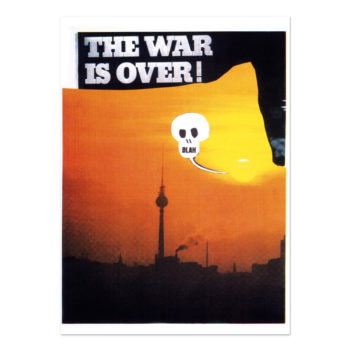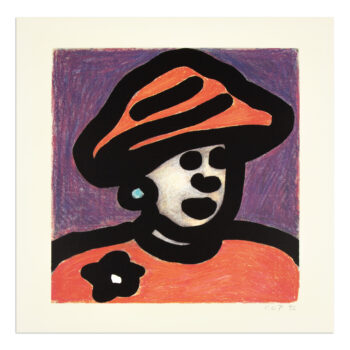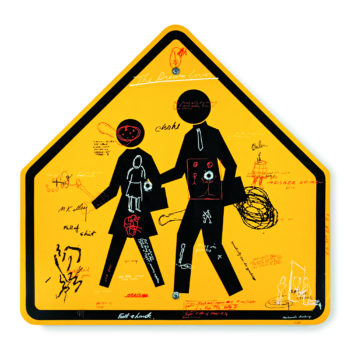-
Wes Lang, Everything
1.600,00 € -
-
Grayson Perry, Piggy Bank
2.200,00 € -
Luc Tuymans, Altar
5.500,00 € -
-
Ai Weiwei, Middle Finger in Black
3.400,00 € -
-
Chris Ofili, R.I.P. Stephen Lawrence
2.400,00 € -
-
-
Daniel Richter, Propaganda II
900,00 € -
-
-
-
David Shrigley, Stink
2.800,00 € -
Wes Lang, To Tell the Truth
4.000,00 € -
Ai Weiwei, Pequi Tree Miniature
2.000,00 € -
Daniel Richter, The War is Over!
5.400,00 € -
-
Otis Kwame Quaicoe, Rancher
4.000,00 € -
JR, Kikito
1.200,00 € -
Marlene Dumas, United Europe
6.400,00 € -
Daniel Richter, Talk is Cheap
5.400,00 € -
JR, Olho, Estadio de Pacaembu
1.200,00 € -
Wes Lang, Thoughts For The Free Life #15
2.800,00 € -
Thomas Ruff, Flieger
1.300,00 € -
Banksy, Welcome Mat
3.400,00 € -
Elizabeth Peyton, Frederick Douglass
3.500,00 € -
-
JR, Death Valley Billboard
2.000,00 € -
Richard Serra, Abu Ghraib
4.400,00 € -
Marina Abramović, 512 Hours
1.500,00 € -
C.O. Paeffgen, Queen
1.000,00 € -
JR, Women Are Heroes
1.600,00 € -
Rashid Johnson, Untitled Anxious Print
5.000,00 € -
JR, Alain
2.600,00 € -
Ai Weiwei, Coca-Cola Glass Vase
5.400,00 € -
Lorna Simpson, III
1.300,00 € -
Jenny Holzer, Inflammatory Essays
7.000,00 € -
Harland Miller, Hate’s Outta Date
12.500,00 € -
David Shrigley, To Hell With Zoos
6.500,00 € -
Luc Tuymans, Wenn der Frühling kommt
4.000,00 € -
David Shrigley, We Won the Race
2.800,00 € -
-
Anne Collier, Woman Crying
3.400,00 € -
-
Jenny Holzer, AKA
3.900,00 € -
-
David Shrigley, The World
4.900,00 € -
John Baldessari, Two Assemblages (Opaque)
3.200,00 € -
Shirin Neshat, Tooba
5.900,00 € -
-
-
-
Ai Weiwei, BOMB
1.900,00 € -
-
David Shrigley, Talk to the Hand
2.600,00 € -
Joseph Beuys, Parteiendiktatur
1.000,00 € -
David Shrigley, I Hate Human Beings
4.500,00 €
Political art is a genre of artistic expression that addresses and challenges political issues, ideologies, and power structures. It aims to provoke thought, inspire activism, and drive social change by highlighting societal injustices, inequalities, and other critical issues. Unlike art created solely for aesthetic purposes, political art is inherently tied to the artist’s intention to comment on or influence political landscapes. It can take various forms, including paintings, prints, sculptures, installations, performances, and digital media, making it a versatile tool for conveying complex political messages. Notable examples of political art include Pablo Picasso’s Guernica, which depicts the horrors of war, and Dropping a Han Dynasty Urn by Ai Weiwei, a provocative commentary on cultural destruction.

The History of Political Art
The roots of political art can be traced back to ancient civilizations, where art was often used to glorify rulers and propagate state ideologies. However, its role as a medium for dissent and social critique became more pronounced during the Enlightenment and subsequent revolutionary periods. For instance, the French Revolution saw artists like Jacques-Louis David using their work to support revolutionary ideals and criticize the monarchy.
In the 20th century, political art gained significant momentum with movements such as Dadaism and Surrealism, which responded to the chaos of World War I and II. Artists like Hannah Höch and George Grosz used collage and grotesque imagery to critique fascism and societal norms. The Mexican muralists, including Diego Rivera and David Alfaro Siqueiros, used large-scale public art to depict the struggles of the working class and advocate for social reforms.
The civil rights movement, anti-Vietnam War protests, and feminist movements of the 1960s and 70s further solidified the role of art in political activism. Artists like Barbara Kruger and Keith Haring used their work to challenge societal norms and promote social justice. This historical context illustrates how political art has evolved as a powerful means of expression and resistance.
Notable Examples of Political Art
Political art has produced numerous iconic artworks and famous political artists who have left an indelible mark on society. Some notable examples include:
Barbara Kruger
Known for her bold, text-based works, Kruger addresses issues of power, identity, and consumerism. Her piece “Untitled (Your Body is a Battleground),” created for the Women’s March on Washington in 1989, tackles reproductive rights and gender inequality. Kruger’s art often uses striking visuals combined with provocative text to challenge viewers’ perceptions.
Ai Weiwei
This Chinese artist and activist uses a variety of mediums to critique political and social issues. His work “Dropping a Han Dynasty Urn” symbolizes the destruction of cultural heritage under authoritarian regimes. Ai Weiwei’s art consistently challenges the Chinese government and advocates for human rights and freedom of expression, making him a prominent figure in contemporary political art.
Banksy
The anonymous British street artist uses his work to address political and social issues with humor and irony. Notable pieces include a young girl frisking a soldier and “Balloon Girl,” both critiquing war, consumerism, and government surveillance. Banksy’s art often appears in public spaces, making his messages accessible and impactful to a broad audience.
JR
This French artist uses large-scale black-and-white photographic installations to make powerful statements on social justice. His “Face2Face” project, which humanized the Israeli-Palestinian conflict, displayed portraits of individuals from both sides, challenging viewers to see beyond political divisions. JR’s work transforms public spaces into platforms for social commentary and dialogue.
Kara Walker
Known for her cut-paper silhouettes, Walker explores themes of race, gender, and violence. Her work “A Subtlety, or the Marvelous Sugar Baby,” a giant sugar-coated sphinx-like sculpture, addressed the history of slavery and the exploitation of African Americans. Walker’s art often confronts viewers with the brutal realities of historical and contemporary racial injustices.
Jenny Holzer
Holzer uses text-based art to address social and political issues. Her “Truisms” series, consisting of provocative statements displayed on LED signs, posters, and other public spaces, challenges viewers to reconsider their beliefs and assumptions. Holzer’s work blends art and language to create powerful and thought-provoking public interventions.
Shirin Neshat
An Iranian visual artist, Neshat explores themes of exile, identity, and gender. Her photographic series “Women of Allah” examines the complexities of female identity in Islamic culture, blending poetry, calligraphy, and imagery. Neshat’s work often reflects her personal experiences and broader socio-political issues affecting women in the Middle East.
Grayson Perry
This British artist uses ceramics, tapestries, and other mediums to critique social issues such as class, identity, and consumerism. His works often incorporate satirical and autobiographical elements, challenging societal norms and expectations. Perry’s art is known for its bold visual style and incisive commentary on contemporary life.
The Impact of Political Art
Political art has the potential to profoundly impact society by raising awareness, sparking dialogue, and inspiring action. Through its ability to convey powerful messages and evoke strong emotions, political art can bring attention to issues that might otherwise be overlooked or ignored.
One of the primary ways political art influences society is by fostering empathy and understanding. By presenting personal and humanized depictions of suffering, oppression, and injustice, political art can bridge gaps between diverse groups and encourage solidarity. For example, JR’s “Face2Face” project aimed to humanize the Israeli-Palestinian conflict by displaying large-scale portraits of individuals from both sides, challenging viewers to see beyond political divisions.
Furthermore, political art can serve as a catalyst for social and political change. By challenging dominant narratives and exposing systemic injustices, it can inspire grassroots movements and influence public policy. The works of famous political artists often become symbols of broader social movements, rallying people around a common cause and motivating them to take action.
Additionally, political art can contribute to the preservation of historical memory. By documenting and interpreting significant events, it helps ensure that future generations remember and learn from the past. This is particularly important in the context of marginalized or oppressed communities whose histories might otherwise be erased or forgotten.
In conclusion, political art plays a vital role in society by addressing pressing issues, fostering empathy, inspiring activism, and preserving historical memory. Through its diverse forms and powerful messages, it continues to challenge and transform the world we live in.































































